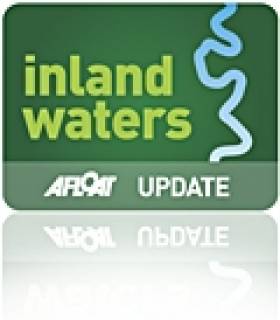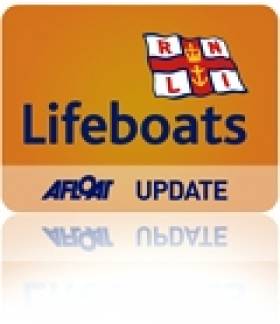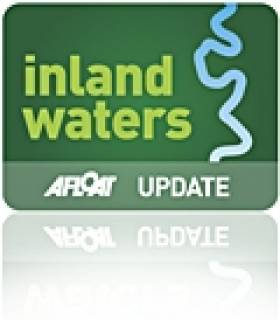Displaying items by tag: Shannon Navigation
Shannon Navigation
20 Metre Weir Boom Installed at Knockvicar
Installing the 20m boom was initiated with assembly of the boom off-site in Rooskey. In early December, the drilling for the piles was facilitated by floating a piling rig to the site on pontoons. Piles are required to hold the Weir Boom in place. The boom was then floated to the site and secured in place. The works cost approximately €55,000.
Installation of the boom improves the amenity at Knockvicar in addition to lock gate replacement and upgraded lockhouse facilities which have been completed by Waterways Ireland in recent years.
The Weir Boom is a preventative measure installed by Waterways Ireland to protect boaters and their craft from being drawn over the weir. Space has been left to allow for the passage of canoeists. There will be no environmental impacts on fish or other wildlife from the installation or operation of the Weir Boom.
'Keenan's of Tarmonbarry' Wins Taste Of Waterways Award
The winner of the prestigious Taste of the Inland Waterways Award was revealed this week by Georgina Campbell as "Keenan's of Tarmonbarry".
Presenting the Taste of the Waterways Award to Keenan's of Tarmonbarry, Martin Dennany, Director of Marketing and Communications, Waterways Ireland stated "Keenan's of Tarmonbarry epitomises the waterway dining experience and I am delighted to present this Taste of the Waterways Award and to commend Georgina Campbell on her choice. With the recent completion of the link between the Royal Canal and the Shannon Navigation, we hope that many will take the opportunity to visit the area and to experience for themselves the delights of waterside hospitality at this fine establishment. Waterways Ireland is happy to sponsor this award and to recognise the contribution that businesses like Keenan's make to the tourism industry".
The Taste of the Waterways Award was first introduced in 2008 and runs in conjunction with "The Taste of Waterways" booklet, a publication produced by Waterways Ireland in partnership with Georgina Campbell highlighting the excellent hospitality of the waterway experience. The guide is free and updated regularly with Georgina's selection of establishments of all kinds serving food and hospitality all along the inland waterways.
Martin Dennany commenting on the guide stated "The judging criteria and standard of assessment for the Taste of the Waterways Georgina Campbell guide is very high, with selection made on merit alone: no payment is charged for entry, no payments accepted for advertising".
Georgina Campbell described Keenan's as "Just beside the bridge over the Shannon in Tarmonbarry, this well-run bar and restaurant has been a favourite watering hole for river folk for many years - and it makes a great place to break a journey between Dublin and the north-west. The range is wide, offering wholesome, hearty fare that pleases all age groups and includes very welcome traditional dishes. But it's for their steaks, above all, that people beat a path to Keenan's of Tarmonbarry - and why wouldn't they? Whether you go for a classic sirloin, a big juicy fillet, or their renowned steak sandwich, the steaks at this hospitable watering hole are not to be missed."
Portumna Bridge Not Opening and Closing Correctly
Waterways Ireland Commences Work on Killaloe Canal
The works on the Shannon Navigation at Killaloe involve the repair and widening of the canal wall. Flow Control Gates will be installed in the canal and new moorings have already been put in place to provide greater capacity. A further outcome of the flow control gates is the incorporation of a pedestrian footbridge creating a looped walk along the canal. The entire walkway will be resurfaced as part of the project.
The works have been designed by Waterways Ireland and will be undertaken by a contractor. The work will commence on the 13th September 2010 and is expected to be completed in March 2011. During this period the footpath between the R463 Killaloe to Scarriff Road and the canal will be closed.
The remedial works to the canal wall include the installation of approximately 400 m of sheet piles to incorporate the extension to the moorings and underpin the existing canal wall. The installation of boat pump-out facility and new mains pump chamber has been included in the programme.
When complete three walkways will link the newly installed floating moorings to the canal wall. The 250m of floating moorings were installed by Waterways Ireland earlier in the year in preparation for this work to take place.
Waterways Ireland would like to apologise for any inconvenience caused during the contract period. Queries about this work can be directed to the Waterways Ireland Western Regional Office in Scarriff, Tel 061 922033.
Take Care Navigating Abbey River When Turbines Operate
Waterways Ireland has issued a reminder to users of the inland waterways on the Shannon Navigation that it is advised not to undertake a voyage if more than one turbine is operating, due to increased velocity of flow in the navigation which can be dangerous. The situation may also arise when flood conditions prevail.
Contact the lock keeper at Ardnacrusha (tel: 087-7972998) for information on the number of turbines in operation at Ardnacrusha before commencing transit of this part of the river.
Lough Derg Lifeboat Assists Vessel Aground
This afternoon at 15.47hrs, Lough RNLI Derg lifeboat Toshiba Wave Warrior launched to assist eight persons on board a 31ft cruiser aground on Lough Derg.
At 15.30hrs on Monday afternoon August 2, Derg RNLI lifeboat was requested to launch following a sighting of a vessel aground off Crane Island close to Church Bay on the south-western shore of Lough Derg. The lifeboat with helm Eleanor Hooker, Peter Clark and Colin Knight on board, launched at 15.47hrs. Winds were south-westerly, Force 2 to 3. The lifeboat was alongside the casualty vessel at 15.58hrs and found all passengers to be safe and unharmed. They were asked to put on their lifejackets. The RNLI Lifeboat Training Officer, Fergal Kerney was afloat at the time and stood-by to reassure the persons on board until the lifeboat arrived. A RNLI crew member climbed aboard the cruiser and after he established that the vessel was not holed or damaged, it was taken off the rocks and towed out into safe water, where another check of steering and rudder was carried out. The cruiser then continued on its journey.
Lough Derg RNLI Lifeboat Operations Manager, Charles Stanley-Smith commended the "the swift response the lifeboat crew and the professional manner in which the rescue was carried out".
The lifeboat returned to station and was ready for service again at 16.40hrs
Related Safety posts
RNLI Lifeboats in Ireland
Safety News
Rescue News from RNLI Lifeboats in Ireland
Coast Guard News from Ireland
Water Safety News from Ireland
Marine Casualty Investigation Board News
Marine Warnings
Shannon Navigation – Sarsfield Lock, Limerick
Waterways Ireland advises that Sarsfield lock, Limerick is now fully operational.
Shannon Navigation - Limerick City Moorings
Waterways Ireland advises Masters and Owners of reduced draft below weir level at moorings in Limerick as follows;
Custom House Quay
0.5m at inside moorings
1.3m at outside moorings
Arthur Quay Moorings
1.2m




































































